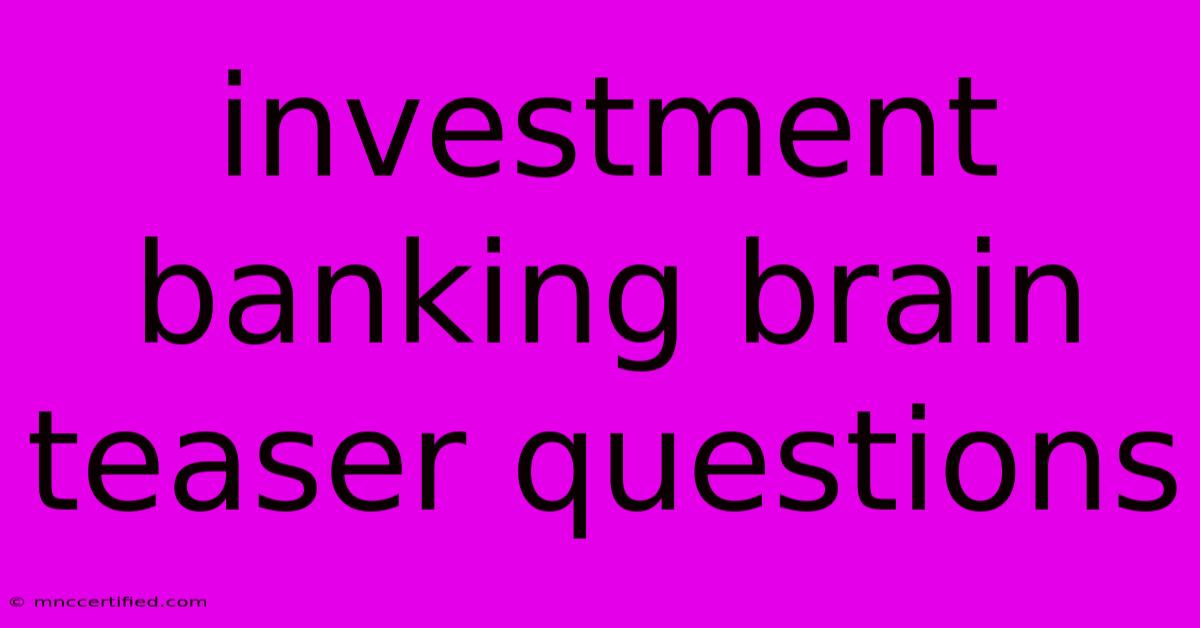Investment Banking Brain Teaser Questions

Table of Contents
Cracking the Code: Investment Banking Brain Teaser Questions
Investment banking interviews are notorious for their rigorous nature, often testing not only your technical skills but also your problem-solving abilities and critical thinking. One common tactic employed by interviewers is the use of brain teaser questions. These questions, seemingly unrelated to finance, serve as a gauge of your analytical thinking, creativity, and ability to handle pressure.
While these questions might seem intimidating at first, with the right approach, you can ace them and impress your interviewer. Here’s a breakdown of why they’re used, common types of questions, and strategies for tackling them:
Why Brain Teaser Questions?
Investment bankers need to be sharp, adaptable, and capable of thinking on their feet. Brain teasers serve as a proxy for these qualities, allowing interviewers to assess your:
- Analytical thinking: Can you break down complex problems into smaller, manageable steps?
- Logical reasoning: Do you approach problems systematically and reach logical conclusions?
- Creativity: Can you think outside the box and come up with innovative solutions?
- Communication skills: Can you explain your thought process clearly and concisely?
- Pressure handling: Do you maintain composure and focus under pressure?
Types of Investment Banking Brain Teaser Questions
Brain teasers come in various flavors, but some common categories include:
- Logic puzzles: These often involve scenarios with specific rules or constraints, requiring you to deduce the correct outcome.
- Estimation problems: You'll be asked to estimate the size of a market, the number of objects in a given space, or the value of a specific asset.
- Wordplay: These questions involve creative thinking and playing with words to arrive at a solution.
- Math-based riddles: These might involve simple math problems presented in a tricky way or require you to apply basic mathematical concepts.
Strategies for Conquering Brain Teaser Questions
While there’s no single magic formula, here are some effective strategies:
1. Stay Calm and Focused: The key is to remain composed under pressure. Take a deep breath, listen carefully to the question, and don't be afraid to ask for clarification if needed.
2. Understand the Goal: Before diving into a solution, clearly define the goal of the problem. What are you trying to achieve?
3. Break it Down: Complex problems become easier to manage when broken down into smaller, manageable steps. Identify the key elements, constraints, and information you need to work with.
4. Think Out Loud: Don't just arrive at an answer silently. Explain your thought process as you work through the problem. This demonstrates your reasoning skills and allows the interviewer to follow your logic.
5. Don't be Afraid to Guess: If you're stuck, it’s better to make an educated guess and explain your reasoning behind it than to remain silent.
6. Practice Makes Perfect: The best way to become comfortable with brain teasers is to practice. Seek out online resources, books, or even practice with friends.
Example Brain Teaser and Solution
Question: You have 100 coins laying flat on a table, each with a head side and a tail side. 10 of them are heads up. You can't see or feel the coins. How many times do you need to flip over coins to guarantee that all coins are heads up?
Solution: You only need to flip over one coin to guarantee all coins are heads up. Here's why:
- Scenario 1: You flip a coin that is currently tails up. It becomes heads up, and you have now increased the number of heads up coins by one.
- Scenario 2: You flip a coin that is currently heads up. It becomes tails up, and you have now decreased the number of heads up coins by one.
Since you start with 10 heads up coins, you're guaranteed to have all coins heads up after 10 flips, regardless of which coins you choose to flip.
Final Thoughts
Brain teasers are a valuable tool for assessing your analytical and problem-solving skills. While they can seem daunting, with the right preparation and approach, you can confidently navigate them and demonstrate your potential to an investment banking firm. Remember to stay calm, think strategically, and showcase your unique thought process.

Thank you for visiting our website wich cover about Investment Banking Brain Teaser Questions. We hope the information provided has been useful to you. Feel free to contact us if you have any questions or need further assistance. See you next time and dont miss to bookmark.
Featured Posts
-
Irrevocable Life Insurance Trust Template
Nov 07, 2024
-
Trump On Space X Starlink Starship Plans
Nov 07, 2024
-
Ivanka Trumps Outfit At Fathers Speech
Nov 07, 2024
-
Trump Presidency Return Fuels Stock Market Surge
Nov 07, 2024
-
Sf Mayoral Race Breed Trails In Latest Results
Nov 07, 2024